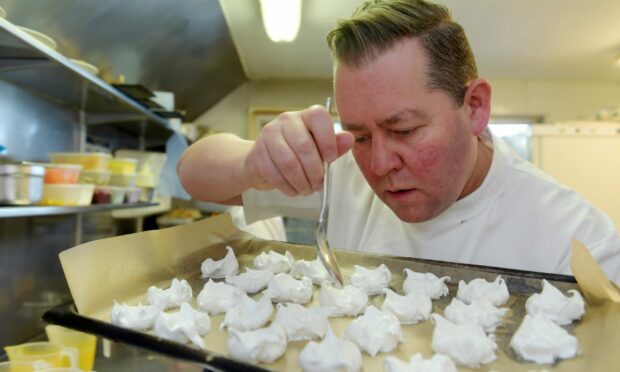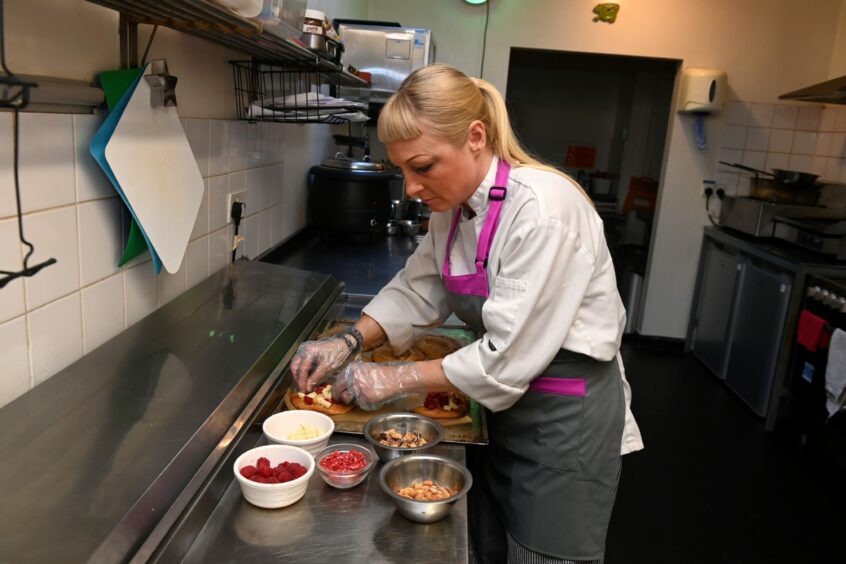Gavin Ellis is angry. I know this because his voice is rising.
And because his dog – spooked by the increasing volume – has run off to hide under a table.
“I’m suddenly emotional because I am emotional,” Gavin acknowledges with a rueful laugh.
The hotelier, who owns the Knockomie Inn and restaurant in Forres, has good reason to raise his voice.
Like many in the hospitality industry, he is feeling the strain of working in an industry tossed around by a combination of factors.
Already a precarious sector buffeted by Brexit and COVID, hospitality is now showing an exposed flank to spiraling energy costs and an unprecedented staff shake-up that has left many businesses acutely short of workers.
Now, as an uncertain winter looms, it is hospitality that will suffer most from the fallout of the past three years, as well as more recent pain of inflation and interest rate rises.
Losing £3,000 a month, even while closed
Take Gavin , for example.
Hemmed in by rising costs, the Mull native has taken the difficult decision to close for the winter. His last customers left just the other week. Gavin and his wife Penny won’t serve them until March.
Outside of COVID, it will be the first time in 35 years that Gavin has mothballed the business.
He says his hands are tied. If he stays open, he’ll lose £15,000 a month. Closed, the hemorrhage is less severe, but will still hurt. His best-case scenario is losing £3,000 a month over the winter.
Hence the anger.
“This crisis has been creeping up for years, and nobody’s grasped it,” Gavin says, the dog now safely under the table.
He quickly lists the major challenges facing hospitality right now: VAT rates that he believes are unfair and more onerous than in other European countries; spiraling insurance costs that for some have doubled; food price rises that are running well above inflation, potentially at around 20%.
“And I haven’t even started on electricity yet,” Gavin adds.
When he does, it is to condemn the “wild west cowboy” energy companies that tried the other week to make him sign a two-year electricity contract on terms he claims would have crippled him.
“I would have taken a sledgehammer to my wires if I’d have to because that was completely signing a suicide note,” Gavin says.
One-third of UK hospitality at risk of closure
Gavin’s frustration is an accurate representation of how the entire hospitality industry is feeling right now.
And he is far from alone in bearing the brunt of what some are calling hospitality’s “cost-of-doing-business crisis”.
Last week, a survey from trade groups including UKHospitality and the British Beer & Pub Association found that more than a third of the UK’s hospitality sector is at risk of going under early next year.
In the north and north-east, a catalogue of cafes, bars, restaurants, coffee shops and other hospitality businesses have been forced to give up in the face of insurmountable obstacles.
Badenoch’s bar and restaurant, a burger joint in Elgin, closed last weekend with its owner saying he felt hospitality had been “left to fend for itself”.
In Aberdeen, Vietnamese restaurant Saigon shut down after 25 years in business, with only a delivery service remaining.
Now, as the economic shockwaves build, the question is: What will the hospitality industry look like after the winter?
Also, what will those changes mean for us, the people that go out and eat in restaurants?
‘There’s just no way that they’re going to survive’
What appears to be certain is that customers will face fewer choices when they go out to eat and drink.
“There will be less hospitality businesses,” says Craig Wilson, who owns Eat on the Green, a fine-dining restaurant run out of a former village pub in Udny Green.
“Places that are serving mediocre [food], there’s just no way that they’re going to survive because nobody is going to take a risk.”
But the good news, Craig adds, is that a more discerning customer will force restaurants to be more creative in what they offer.
“Creativity is just absolutely key,” he says. “And it’s not just coming up with a combination of flavors , it’s about being creative with the format for your business.”
At Eat on the Green, for example, Craig has started up something he calls a restaurant box – a dinner delivered to your door that offers the full restaurant experience at home.
Meanwhile, over lockdown, Craig launched a supper club, which continues to attract high demand. The concept brings local producers to an intimate dinner with a handful of diners, who can see first-hand the quality of the produce they are eating.
“It’s a good example of something that shows there is an appetite for this sort of thing, and that people want to support it,” Craig says.
How staff shortages will force restaurants to rethink hiring
Top of the challenges for restaurants, hotels, pubs and cafes right now is hiring – and retaining – staff.
Brexit forced the departure of many kitchen and hotel workers from the UK, while a rise in demand for delivery driver jobs lured many staff away from hospitality’s low-paid and demanding jobs.
“I’m terrified as to where we’re going to find staff from,” says Gavin at Knockomie Inn. That lack of talent, he says, will be one of the key obstacles to his reopening in the spring.
“If we can’t find a chef at a rate that my customers that can afford to pay the bills, then we will have to be imaginative about what our food offering is.”
At Isle of Skye restaurant Edinbane Lodge, owner and head chef Calum Montgomery believes more creative thinking is required to solve hospitality’s staffing crisis.
The Skye native, who appeared on Great British Menu earlier this year, is concerned that young people no longer want to work in restaurants because they don’t see it as a viable career.
Instead, they think of hospitality as a badly-paid job made even worse by long hours.
They’re not wrong.
“You would not stack shelves and get paid for a nine-to-five Monday to Friday shift but you’re actually there from seven in the morning until midnight, six days a week,” Calum says. “It just wouldn’t happen. And yet that’s what happens in hospitality.”
A legally-mandated four-day week
To change this, Calum advocates a four-day working week for all hospitality staff to make up the long hours.
He’s already installed the scheme at Edinbane. The chef credits it for helping to shift the work-life balance in his staff’s favour.
“The industry is changing, and it’s changing for the better,” says Calum, who is adamant the winds are blowing in his direction. So much so that he thinks it’s just a matter of time before employment law falls into step.
“I absolutely believe it will be illegal for chefs to work five days a week within the next couple of years.”
A co-operative approach to running a restaurant
Calum is not the only restaurant owner with a creative solution to staff shortages.
Leeanne Coutts, owner of Aberdeen’s Richmond Street Deli, has closed her doors a number of times this year because of a lack of staff.
As she prepares to reopen again from yet another temporary closure, she believes Aberdeen’s hospitality future could lie in co-operatives – businesses that are owned and controlled by their members.
For Leeanne, giving an employee a vested interest would motivate them to stick around.
“Trying to get people that don’t have a vested interest to work well has become a lot harder, especially when you can’t afford to pay top rates,” she says.
‘This is a national crisis’
Leeanne, however, remains pessimistic about what lies ahead for hospitality.
Her community café – which serves all-day breakfasts, wraps and deli sandwiches – has been at the sharp end of the downturn. The turmoil, she says, has taken its toll on her health and her relationships.
“I’m actually praying for a miracle right now,” she says. “The last thing I want to do is give up on this. But I don’t think I’ve got any choice. And I know I’m not the only one.”
At Knockomie Inn, Gavin puts it in even starker terms.
“This is a national crisis,” he says. “There is going to be mass unemployment unless somebody steps up. This could wreck Scotland’s rural economy in particular for generations to come.”









Conversation